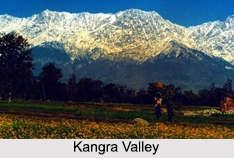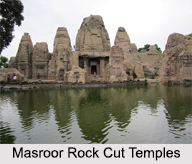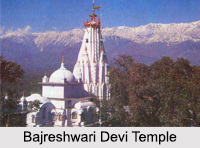 Sheltered by the sublime Dhauladhar Range, the Kangra Valley is lush green and lies in the Indian state of Himachal Pradesh. This exotic valley lies between the Dhauladhar Range and the Shivalik foothills are the conglomeration of valleys and plateaus of the Himalayas. It is one of the most pleasant and relaxing destination in the Himalayas. The Kangra Valley is situated in the Western Himalayas and is home to the Masroor Rock Cut Temple, also known as Himalayan Pyramids, is likely to contend for the UNESCO World Heritage Site.
Sheltered by the sublime Dhauladhar Range, the Kangra Valley is lush green and lies in the Indian state of Himachal Pradesh. This exotic valley lies between the Dhauladhar Range and the Shivalik foothills are the conglomeration of valleys and plateaus of the Himalayas. It is one of the most pleasant and relaxing destination in the Himalayas. The Kangra Valley is situated in the Western Himalayas and is home to the Masroor Rock Cut Temple, also known as Himalayan Pyramids, is likely to contend for the UNESCO World Heritage Site.
History of Kangra Valley
In the ancient times, the Kangra Valley was called as Nagarkot, as it was the ancient capital of the hill state of Nagarkot. The history of Kangra valley dates back to the Vedic times, more than 3500 years ago. There was once a time when Kangra was home to the world`s oldest serving Royal dynasty- the Katoch. The town was also ruled by some great invaders like Mahmud of Ghazni in the 11th century, Mohammed Bin Tuglaq in the year 1337, Raja Purab Chand in 1351 and finally, after the first Anglo-Sikh War it was acquired by the British Empire. Despite the blitz and political turmoil, the region of Kangra has continued to develop and flourish.
Geography of Kangra Valley
With an average elevation of 2000 ft, the Kangra Valley is filled with numerous perennial streams, which irrigate the valley. It is a strike valley and extends from the foot of the Dhauladhar Range to the south of the Beas River. The distinct regional dialect of the area is Kangri.
 Climate of Kangra Valley
Climate of Kangra Valley
The Kangra Valley enjoys an alpine type of climate with mild summers and chilly winters. During the summer months the temperature reaches a maximum of 34 degree Celsius while the minimum is 20 degree Celsius. And, during the cold months of winter the minimum temperature is almost 1 degree Celsius while the maximum temperature is 20 degree Celsius.
Flora and Fauna of Kangra Valley
The Kangra Valley is well protected by the Dhauladhar range. The valley provides the magnificent view of the Dhauladhar Range in gentle slopes covered with the forests of pine, orchards, tea gardens and terraced fields. The biggest attraction of the region is the migratory birds from Siberia during the winter season. Tourists may spot animals like cheetal, black buck and cranes roaming in this area. The valley is known for the scenic beauty, ancient temples and numerous adventure sports.
Tourism in Kangra Valley
The Kangra Valley is clad with a number of sightseeing places, which makes it a perfect holiday destination. Listed below are of the important tourist attractions of the Kangra Valley.
Masroor Rock Cut Temples: Known for its monolithic rock-cut temples, Masroor is 38 km from the town of Kangra. There are 15 rock-cut temples in Indo-Aryan style and are richly carved. It is a unique monolithic structure in the sub-Himalayan region and is a protected monument. The main shrine contains three stone images of Lord Rama, Lakshmana and Sita. The temple complex is located on a hill and also has a large rectangular water pond. The view of the snow clad Dhauladhar Range is amazing from the temple premises.
Bajreshwari Devi Temple: In the middle of the town of Kangra is this temple dedicated to Bajreshwari Devi. It is one of the 51 Shakti Peethas, which was once known for its legendary wealth. The temple was subjected to successive depredations by invaders from the north. Destroyed completely in 1905 by an earthquake, it was rebuilt in 1920 and continues to be a busy place of pilgrimage. In the surroundings of Kangra, tourists can also visit the historical Kangra Fort at Old Kangra and also trek up to the temple of Jayanti Devi located on the hill top, opposite to the Kangra fort.
 Mahrana Pratap Sagar: Named in the honour of the great patriot Maharana Pratap Singh (1572-97 AD) the Maharana Pratap Sagar also known as the Pong Lake is situated at an altitude of 450m above sea level. Surrounded by pristine blue water and with a panoramic view of the Dhauladhar Ranges and Kangra Valley makes the visit to Ransar Island an unforgettable experience. The tourists visiting this place will be able to see animals like the black buck and cheetal along with surkhab, cranes, pintails and a variety of water birds. The best season to visit the Pong Lake is between the months of September to March.
Mahrana Pratap Sagar: Named in the honour of the great patriot Maharana Pratap Singh (1572-97 AD) the Maharana Pratap Sagar also known as the Pong Lake is situated at an altitude of 450m above sea level. Surrounded by pristine blue water and with a panoramic view of the Dhauladhar Ranges and Kangra Valley makes the visit to Ransar Island an unforgettable experience. The tourists visiting this place will be able to see animals like the black buck and cheetal along with surkhab, cranes, pintails and a variety of water birds. The best season to visit the Pong Lake is between the months of September to March.
Kangra Fort: The historical Kangra Fort was built by Bhuma Chand and had been the centre of attraction for the rulers of northern India, since a long time. The remains of the fort of the rulers of Kangra are located on a strategic height, overlooking the Ban Ganga and Manjhi rivers. The first attack on the fort was made by the Raja of Kashmir, Shreshtha in 470 AD. In 1846 Kangra fort fell into the hands of the British. The temple of Laxmi Narayan and Adinath located inside the Kangra Fort are dedicated to Jainism. Inside the fort are also two ponds, one of them is called Kapur Sagar.
Other attractions include the Nagarkot Fort, Chintpurni Temple, the cave temples of Trilokpur, Nurpur Fort, etc.
Activities in Kangra Fort
In this region, tourists can partake in adventure sports as the Kangra Valley is an ideal location for these kinds of activities, be it trekking, mountaineering, para-sailing or hang gliding. The valley holds the hang-gliding rally annually. There are many trekking routes passing through the Dhauladhar ranges, where the trekkers can experience the beautiful surroundings of the hills and dense forests. Para-gliding is another popular sport of the Kangra Valley bringing the adventure sports lovers from all over the world. Tourists can also take the excursion trip from Kangra to the small town of Masrur and to the Jawalmukhi temple.
Visiting Information on Kangra Valley
The nearest broad gauge railhead is Pathankot at a distance of 70 km and the Kangra Airport is the closest located at a distance of 13 km from the city of Kangra.






